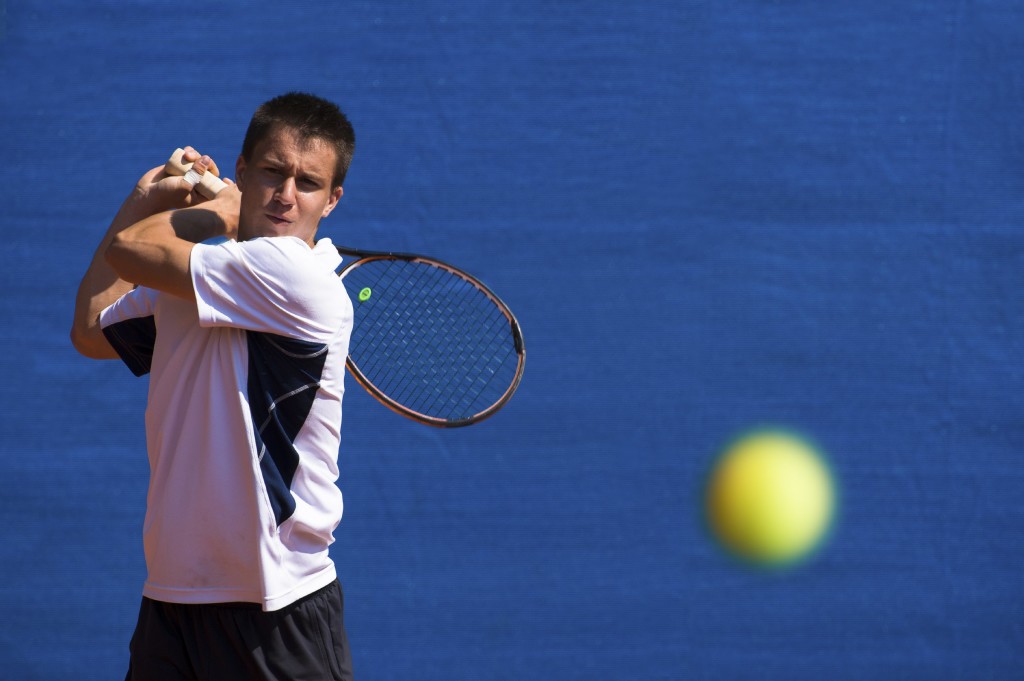“I hate that word — lesson,” Billie Jean King told me when I said I worked for MyTennisLessons.com.
Oh, nice to meet you, too.
We’re not planning on changing the name of the website any time soon, Billie, but you kind of have a point.
The word “lesson,” according to the dictionary, can mean “a thing learned by a student,” “an example or punishment that serves to warn someone,” or a “biblical passage read aloud during church.” Woof. School, punishment and church. Lessons do not sound found.
Tennis lessons are fun, though, and they’re not just about mind-numbing drills (another misleading tennis word) devoid of fun and competition.
My favorite drills are those that simulate match play and allow the student to get competitive — whether against another player, their coach or even themselves.
Both coaches and students of all skill levels should check out these fun drills ideas that can be done with multiple players or in a one-on-one lesson.
Skill level: Beginner
Beginners need to learn the basics, but standing still and hitting groundstroke after groundstroke isn’t fun for anyone. Drills that emphasize cardio, consistency and competition give beginning players a reason to get excited about tennis.
1. Easy as 1,2,3
Beginning players need repetition while also setting goals. For this drill, players simply stand on opposite sides of the service line and count as they hit the ball back and forth as many times as possible. Advanced beginners should practice this with volleys, closing in on the net after every shot. This drill allows players to focus on building fundamentals, but setting goals to hit five, 10 or 20 shots in a row motivates them to perform better.
2. Target practice
Beginners aren’t ready to talk strategy yet, but they can certainly get started on shot placement. Set up a quad of tennis balls at a particular spot on the court (e.g. the point where the service line and doubles alley meet). Fashion the tennis balls so that three form a triangle and one sits atop, like this. The player will then try to hit the target off a feed. This can be done with groundstrokes, volleys and serves. Prizes for hitting the target make it even more fun!
3. Catch me if you can
When learning stroke technique, beginners are often standing still so that they can perfect grip and form and more easily connect with the ball. Fitness is an important part of tennis, however, so beginners shouldn’t be standing still throughout the entire lesson. For this cardio drill, one person stands between the baseline and service line, racket in hand. The person on the opposite side of the net does not have a racket, but hand feeds the ball to the other player. The player with the racket then hits the ball over the net and the feeder tries to catch it in the air or on the first bounce. After the ball is retrieved, both people sprint up to the net and switch racket and ball, then backpedal to their starting positions. Repeat the drill several times and include a point-keeping system for balls caught.
4. Play back
After a player has become acquainted with tennis, they are capable of holding a rally. Coaches can engage beginning players in point play by having them play out, let’s say, every sixth ball in a groundstroke feeding drill. Since the coach will likely be standing at the net, they can easily control the ball and hit it back to the player in order to keep a rally. Children, especially, will be thrilled by the idea of “beating” their coach in a point.
Skill level: Intermediate
At the intermediate level, students have a solid foundation of stroke technique and should begin to learn about strategy and match play. Live ball drills will test their skills, develop their ability to plan points and mentally prepare them for competitive play. Plus it’s oh-so-fun to keep score.
5. Think outside the (service) box
Play a game (first to 21 typically works well), starting the point with a drop feed. When a player hits the ball within the service box, they automatically lose the point. The opposing player then gets not one, but two points added to their score for this error. While an intermediate player might still be hitting a lot of shots in the middle of the court, this drill will teach them through competition about shot placement and how to consistently hit the ball deep.
6. Nothing but net
Building upon the service box game, intermediate players should be learning to attack the net if a ball comes short. In this version of the game, if a shot is hit within the service box, the opposing player must approach and finish the point at the net. If they win at the net, they receive two points; if they lose, the score is unchanged (since the other player would lose a point for hitting a shot in the short court). This punishment and reward system encourages players to be aggressive and take risks.
7. Keep it short
Many players at the intermediate level are not yet able to slice or chip the ball effectively. Practice these strokes by playing a short-court game — anything outside the service line is out. Simply drop feed the ball and play out the point. The catch? No topspin! Players should be focusing on short chips and wide angles. Making the court smaller allows them to better develop these skills before incorporating them into match play.
8. No second chances
Serving is one of the most mentally challenging aspects of the game. Even when experienced players start to feel pressure in a match, their serve is one of the first strokes to break down. Play an abridged match (first to four games is a good start) in which the serving player only gets one serve. This drill helps players realize the importance of having a good serve and how it can set the tone for a point, and requires them to focus on consistency and control. For people who love serving, this drill is a blast.
9. Under pressure
Another way to simulate pressure is for one player to serve every game down 0-15 or 0-30. This is mentally challenging, but super satisfying to come back and win.
Skill level: Advanced
Most advanced players can hit a powerful topspin forehand and keep the ball in play for 50 shots in a row. But what about those less-emphasized strokes and skills like drop shots, wide angles and volleys? With today’s big baseline games, it pays to have a few tricks up your sleeve. Right, Roberta Vinci?
10. Instructional Video Content
Below are some drills that will help shake up your usual training routine but Topcourt is a online video platform where you can learn drills, technique, and hear stories from some of the best professional tennis players and coaches in the world. Want to pick up some tips to sharpen your inside out forehand from Sloane Stephens? Maybe you’re trying to learn something as specific as a lefty serve out wide from Fernando Verdasco? There are dozens and dozens of videos and professionals to explore. Try it for free for 14-days.
11. Be an alley cat
Perfect aim by making the court small — really small. Play a point game in which the only part of the court that’s in is the doubles alley. Both players should start on the deuce or ad side of the court so that they’re practicing down-the-line shots. Then switch to the other side for round two. The game gets even more challenging when players stand crosscourt from each other. Play four games total so that each player works the forehand and backhand side both down the line and crosscourt.
12. Drop it like it’s hot
Running drills are exhausting, but essential. Try this short-ball drill that requires hitting different types of winners. The player starts on the center of the baseline and the coach feeds them a short ball to the forehand or backhand. The player must run up, hit a down-the-line topspin winner and quickly backpedal to the center of the baseline. As soon as they touch the baseline, the coach then feeds an even shorter ball (to either side) and the player must hit a drop-shot winner, backpedal to the baseline and be prepared to hit the next ball. The cycle repeats until the hopper of balls is empty or the player is exhausted (they will be).
13. One move ahead
Stop practicing static volleys and start moving. In this drill, both players stand directly across from one another at the service line on the far end of the ad or deuce side. Players should then move swiftly across to the other side while hitting down-the-line volleys to each other. Then move back the other way, switching the racket to the other hand. Repeat the drill, but practice crosscourt volleys this time. A variation of the drill would be standing crosscourt from each other and moving in opposite directions while hitting crosscourt volleys.
14. Rise up
Play a point game at the baseline — literally. In this drill, players practice hitting the ball on the rise and attacking shots by not being able to move farther back than the baseline. One step behind the white line and the point is over. Watch out for lobs.



